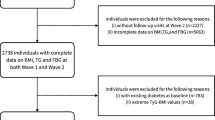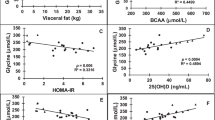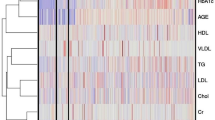Abstract
Objectives:
Body size is postulated to modulate type 1 diabetes as either a trigger of islet autoimmunity or an accelerator to clinical onset after seroconversion. As overweight and obesity continue to rise among children, the aim of this study was to determine whether human leukocyte antigen DQ (HLA-DQ) genotypes may be related to body size among children genetically at risk for type 1 diabetes.
Methods:
Repeated measures of weight and height were collected from 5969 children 2–4 years of age enrolled in The Environmental Determinants of Diabetes in the Young prospective study. Overweight and obesity was determined by the International Obesity Task Force cutoff values that correspond to body mass index (BMI) of 25 and 30 kg m−2 at age 18.
Results:
The average BMI was comparable across specific HLA genotypes at every age point. The proportion of overweight was not different by HLA, but percent obesity varied by age with a decreasing trend among DQ2/8 carriers (P for trend=0.0315). A multivariable regression model suggested DQ2/2 was associated with higher obesity risk at age 4 (odds ratio, 2.41; 95% confidence interval, 1.21–4.80) after adjusting for the development of islet autoantibody and/or type 1 diabetes.
Conclusions:
The HLA-DQ2/2 genotype may predispose to obesity among 2–4-year-old children with genetic risk for type 1 diabetes.
This is a preview of subscription content, access via your institution
Access options
Subscribe to this journal
Receive 12 print issues and online access
$259.00 per year
only $21.58 per issue
Buy this article
- Purchase on SpringerLink
- Instant access to full article PDF
Prices may be subject to local taxes which are calculated during checkout



Similar content being viewed by others
References
Tuomilehto J . The emerging global epidemic of type 1 diabetes. Curr Diab Rep 2013; 13: 795–804.
Sheehy MJ, Scharf SJ, Rowe JR, Neme de Gimenez MH, Meske LM, Erlich HA et al. A diabetes-susceptible HLA haplotype is best defined by a combination of HLA-DR and -DQ alleles. J Clin Invest 1989; 83: 830–835.
Notkins AL, Lernmark Å . Autoimmune type 1 diabetes: resolved and unresolved issues. J Clin Invest 2001; 108: 1247–1252.
Onkamo P, Vaananen S, Karvonen M, Tuomilehto J . Worldwide increase in incidence of Type I diabetes—the analysis of the data on published incidence trends. Diabetologia 1999; 42: 1395–1403.
Keenan H, el Deirawi K, Walsh M, Grover VV, Alva E, Onyemere K et al. Are trends in diabetes incidence changing for minority children? Ann Epidemiol 2000; 10: 459.
Libman IM, LaPorte RE, Becker D, Dorman JS, Drash AL, Kuller L . Was there an epidemic of diabetes in nonwhite adolescents in Allegheny County, Pennsylvania? Diabetes Care 1998; 21: 1278–1281.
Waldhor T, Schober E, Karimian-Teherani D, Rami B . Regional differences and temporal incidence trend of Type I diabetes mellitus in Austria from 1989 to 1999: a nationwide study. Diabetologia 2000; 43: 1449–1450.
Stanescu DE, Lord K, Lipman TH . The epidemiology of type 1 diabetes in children. Endocrinol Metab Clin North Am 2012; 41: 679–694.
Borchers AT, Uibo R, Gershwin ME . The geoepidemiology of type 1 diabetes. Autoimmun Rev 2010; 9: A355–A365.
Knerr I, Wolf J, Reinehr T, Stachow R, Grabert M, Schober E et al. The 'accelerator hypothesis': relationship between weight, height, body mass index and age at diagnosis in a large cohort of 9,248 German and Austrian children with type 1 diabetes mellitus. Diabetologia 2005; 48: 2501–2504.
Charkaluk ML, Czernichow P, Levy-Marchal C . Incidence data of childhood-onset type I diabetes in France during 1988-1997: the case for a shift toward younger age at onset. Pediatric Res 2002; 52: 859–862.
Vehik K, Hamman RF, Lezotte D, Norris JM, Klingensmith GJ, Dabelea D . Childhood growth and age at diagnosis with type 1 diabetes in Colorado young people. Diabet Med 2009; 26: 961–967.
Vehik K, Hamman RF, Lezotte D, Norris JM, Klingensmith GJ, Rewers M et al. Trends in high-risk HLA susceptibility genes among Colorado youth with type 1 diabetes. Diabetes Care 2008; 31: 1392–1396.
Fourlanos S, Varney MD, Tait BD, Morahan G, Honeyman MC, Colman PG et al. The rising incidence of type 1 diabetes is accounted for by cases with lower-risk human leukocyte antigen genotypes. Diabetes Care 2008; 31: 1546–1549.
Wilkin TJ . The accelerator hypothesis: weight gain as the missing link between Type I and Type II diabetes. Diabetologia 2001; 44: 914–922.
Wilkin TJ . Diabetes: 1 and 2, or one and the same? Progress with the accelerator hypothesis. Pediatr Diabetes 2008; 9 (3 Pt 2) 23–32.
Hyppönen E, Virtanen SM, Kenward MG, Knip M, Akerblom HK . Group CDiFS Obesity, increased linear growth, and risk of type 1 diabetes in children. Diabetes Care 2000; 23: 1755–1760.
Carlsson A, Kockum I, Lindblad B, Engleson L, Nilsson A, Forsander G et al. Low risk HLA-DQ and increased body mass index in newly diagnosed type 1 diabetes children in the Better Diabetes Diagnosis study in Sweden. Int J Obes (Lond) 2012; 36: 718–724.
Libman IM, Pietropaolo M, Arslanian SA, LaPorte RE, Becker DJ . Changing prevalence of overweight children and adolescents at onset of insulin-treated diabetes. Diabetes Care 2003; 26: 2871–2875.
Gimenez M, Aguilera E, Castell C, de Lara N, Nicolau J, Conget I . Relationship between BMI and age at diagnosis of type 1 diabetes in a Mediterranean area in the period of 1990-2004. Diabetes Care 2007; 30: 1593–1595.
Kaminski BM, Klingensmith GJ, Beck RW, Tamborlane WV, Lee J, Hassan K et al. Body mass index at the time of diagnosis of autoimmune type 1 diabetes in children. J Pediatr 2013; 162: 736–740 e731.
Larsson HE, Hansson G, Carlsson A, Cederwall E, Jonsson B, Larsson K et al. Children developing type 1 diabetes before 6 years of age have increased linear growth independent of HLA genotypes. Diabetologia 2008; 51: 1623–1630.
TEDDY Study Group. The Environmental Determinants of Diabetes in the Young (TEDDY) study: study design. Pediatr Diabetes 2007; 8: 286–298.
Hagopian WA, Lernmark A, Rewers MJ, Simell OG, She JX, Ziegler AG et al. TEDDY—The Environmental Determinants of Diabetes in the Young: an observational clinical trial. Ann N Y Acad Sci 2006; 1079: 320–326.
Cole TJ, Bellizzi MC, Flegal KM, Dietz WH . Establishing a standard definition for child overweight and obesity worldwide: international survey. BMJ 2000; 320: 1240–1243.
Vehik K, Fiske SW, Logan CA, Agardh D, Cilio CM, Hagopian W et al. Methods, quality control and specimen management in an international multicentre investigation of type 1 diabetes: TEDDY. Diabetes Metab Res Rev 2013; 29: 557–567.
Kiviniemi M, Hermann R, Nurmi J, Ziegler AG, Knip M, Simell O et al. A high-throughput population screening system for the estimation of genetic risk for type 1 diabetes: an application for the TEDDY (the Environmental Determinants of Diabetes in the Young) study. Diabetes Technol Ther 2007; 9: 460–472.
Erlich H, Valdes AM, Noble J, Carlson JA, Varney M, Concannon P et al. HLA DR-DQ haplotypes and genotypes and type 1 diabetes risk: analysis of the type 1 diabetes genetics consortium families. Diabetes 2008; 57: 1084–1092.
Li M, Yu L, Tiberti C, Bonamico M, Taki I, Miao D et al. A report on the International Transglutaminase Autoantibody Workshop for Celiac Disease. Am J Gastroenterol 2009; 104: 154–163.
Winkler C, Marienfeld S, Zwilling M, Bonifacio E, Ziegler AG . Is islet autoimmunity related to insulin sensitivity or body weight in children of parents with type 1 diabetes?. Diabetologia 2009; 52: 2072–2078.
Sterner Y, Torn C, Lee HS, Larsson H, Winkler C, McLeod W et al. Country-specific birth weight and length in type 1 diabetes high-risk HLA genotypes in combination with prenatal characteristics. J Perinatol 2011; 31: 764–769.
Sanjeevi CB, Sedimbi SK, Landin-Olsson M, Kockum I, Lernmark Å et al. on behalf of the Swedish Childhood D The Risk Conferred by HLA-DR and DQ for Type 1 Diabetes in 0–35-Years Age Group are Different in Different Regions of Sweden. Ann N Y Acad Sci 2008; 1150: 106–111.
Graham J, Hagopian WA, Kockum I, Li LS, Sanjeevi CB, Lowe RM et al. Genetic Effects on Age-Dependent Onset and Islet Cell Autoantibody Markers in Type 1 Diabetes. Diabetes 2002; 51: 1346–1355.
Redondo MJ, Fain PR, Eisenbarth GS . Genetics of Type 1 A Diabetes. Recent Prog Horm Res 2001; 56: 69–90.
Guzik TJ MD, Korbut R . Adipocytokines—novel link between inflammation and vascular function? J Physiol Pharmacol 2006; 57: 505–528.
Eizirik DL, Colli ML, Ortis F . The role of inflammation in insulitis and beta-cell loss in type 1 diabetes. Nature reviews. Endocrinology 2009; 5: 219–226.
Jeffery AN, Metcalf BS, Hosking J, Streeter AJ, Voss LD, Wilkin TJ . Age Before Stage: Insulin Resistance Rises Before the Onset of Puberty: A 9-year longitudinal study (EarlyBird 26). Diabetes Care 2012; 35: 536–541.
Kagnoff MF . Celiac disease: pathogenesis of a model immunogenetic disease. J Clin Invest 2007; 117: 41–49.
Ogden CL, Carroll MD, Curtin LR, Lamb MM, Flegal KM . Prevalence of high body mass index in US children and adolescents, 2007-2008. JAMA 2010; 303: 242–249.
Norberg C, Hallstrom Stalin U, Matsson L, Thorngren-Jerneck K, Klingberg G . Body mass index (BMI) and dental caries in 5-year-old children from southern Sweden. Community Dent Oral Epidemiol 2012; 40: 315–322.
Vuorela N, Saha M-T, Salo M . Prevalence of overweight and obesity in 5- and 12-year-old Finnish children in 1986 and 2006. Acta Paediatr 2009; 98: 507–512.
Vuorela N, Saha M-T, Salo MK . Change in prevalence of overweight and obesity in Finnish children – comparison between 1974 and 2001. Acta Paediatr 2011; 100: 109–115.
Acknowledgements
This study was funded by U01 DK63829, U01 DK63861, U01 DK63821, U01 DK63865, U01 DK63863, U01 DK63836, U01 DK63790, UC4 DK63829, UC4 DK63861, UC4 DK63821, UC4 DK63865, UC4 DK63863, UC4 DK63836 and UC4 DK95300 and Contract No. HHSN267200700014C from the National Institute of Diabetes and Digestive and Kidney Diseases (NIDDK), National Institute of Allergy and Infectious Diseases (NIAID), National Institute of Child Health and Human Development (NICHD), National Institute of Environmental Health Sciences (NIEHS), Juvenile Diabetes Research Foundation (JDRF), and Centers for Disease Control and Prevention (CDC).
AUTHOR CONTRIBUTIONS
JY and KV researched data, contributed to discussion, wrote the manuscript and reviewed and edited the manuscript. AL contributed to discussion, reviewed and edited the manuscript. UMU, KFL, RV, CW, HEL, MR, JXS, AGZ, OGS, WAH, BA, and JPK reviewed the manuscript. JY is the guarantor of this work and, as such, had full access to all the data in the study and takes final responsibility for the decision to submit for publication.
Author information
Authors and Affiliations
Consortia
Corresponding author
Ethics declarations
Competing interests
The authors declare no conflict of interest.
Additional information
Supplementary Information accompanies this paper on International Journal of Obesity website
Supplementary information
Rights and permissions
About this article
Cite this article
Yang, J., Lernmark, Å., Uusitalo, U. et al. Prevalence of obesity was related to HLA-DQ in 2–4-year-old children at genetic risk for type 1 diabetes. Int J Obes 38, 1491–1496 (2014). https://doi.org/10.1038/ijo.2014.55
Received:
Revised:
Accepted:
Published:
Issue date:
DOI: https://doi.org/10.1038/ijo.2014.55
Keywords
This article is cited by
-
The impact of breastfeeding on childhood obesity in children that were large-for-gestational age: retrospective study from birth to 4 years
Scientific Reports (2022)
-
Sex-specific associations between prenatal antibiotics exposure and offspring’s body mass index
International Journal of Obesity (2020)
-
Differential genome-wide DNA methylation patterns in childhood obesity
BMC Research Notes (2019)



